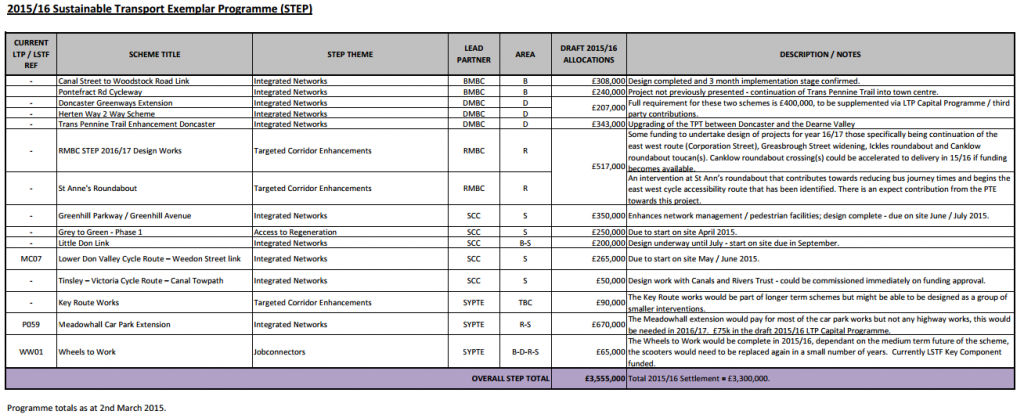 You just couldn’t make it up. Does car parking really count as sustainable transport?
You just couldn’t make it up. Does car parking really count as sustainable transport?
The Sheffield City Region Growth Deal includes a ‘Sustainable Transport Exemplar Programme’ with £16.3m investment for five years from 2015/16 to 2021, with £3.3million in the first year.
The list of schemes funded in the first year has been announced and include things like bike paths and pedestrian crossings.
The largest scheme though, at £670,000, is a “Meadowhall Car Park Extension”. You read that right, a car park extension. 19% of the annual sustainable transport exemplar programme budget this year is being spent on a car park extension.

This money could pay for significant amounts of bike paths, cycle parking, reducing through traffic, 20mph zones etc. etc. etc. This year the Sheffield budget for 20mph zones is £400,000, the budget for this car park extension is £670,000.
I’m appalled. Follow the money, and it’s clear what the true priorities are for transport spending.
Schemes announced at Monday 16th March meeting of Sheffield City Region Combined Authority Transport Committee.
3 replies on “South Yorkshire Sustainable Transport Exemplar Programme – The biggest project in 2015/16 is a car park extension!”
Sadly not the only example of misspent “sustainable transport” money. Here in Worthing the council are spending some £6million of sustainable transport money on repaving an existing pedestrianised shopping street. Apparently it’s a scheme for shoppers, shoppers walk, and walking is sustainable transport. No-one seems to care about the pollution and congestion and danger caused by all the motor vehicles clogging the town.
Car parks fail miserably in their utilisation, and sustainability incices, and equally mess up the utilisation and sustainabliity of the roads feeding them.
Just as the private car demonstrates about the worst asset utilisation possible (on average a UK private car sits idle and unused for 96% of the time – no commercial business would have an expensive asset so under used) the car parks are equally wasteful filled by vehicles which then do not move for 40-60% of the day and then largety empty overnight.
This in turn delivers massive demand for road capacity for very short periods as drivers struggle to all get in or out of car parks at the same time – a condition dramatically demonstrated in Glasgow where the access to the M8 seizes up from around 16.00 but those same roads can be deserted by 18.30 thanks to the massive and expanding provision of car parking in the city core. No one seems to have thought through the fact that is each car takes say 6 seconds (very optimistically) clear the route out from a car parking space then the last car to leave a 2000 space car park (all leaving at the same time) with a simple restricted route out will take 200 minutes – nearly 3.5 HOURS to get out. We have around 20,000 parking spaces in the city core, but the dispersal across a range of routes does mitigate that impact.
Providing more car parking at a location which experiences such peak loading patterns is a planning disaster. Meadowhall aready generates massive queues backing up along the M1 from the Tinsley viaduct and creating a significant hazard on the Motorway of 1-2 lanes of static and slow moving traffic and 1-2 lanes of traffic travelling at up to 70mph, with no ‘smart motorway’ management. It would be interesting to plot crash reporting and investigation (if any is done at all to the standards we see for rail and air safety) – the HA (now HE) network has not even had the Section 39 (RTA 1988) requirement to investigate crashes and apply appropriate remedial measures, and even the new regulated regime defers from giving the regulator a role in setting safety standards.
So not only unsustainable but potentially detrimental to road safety?
They already have overflow car parks (rarely used, even at peak shopping times such as Christmas). What gives?